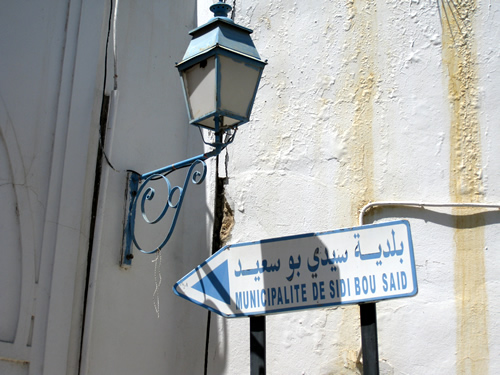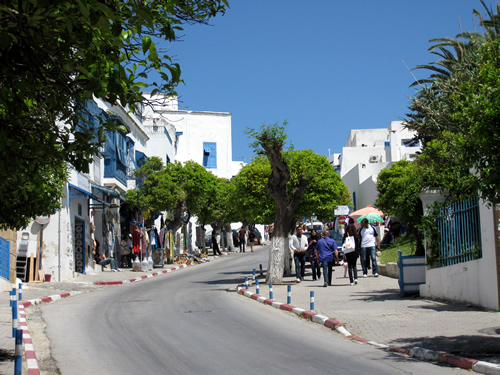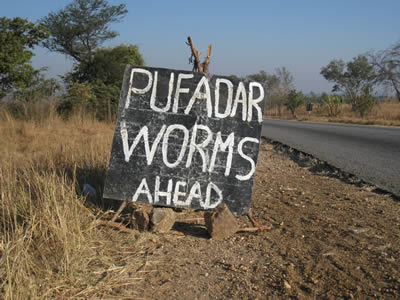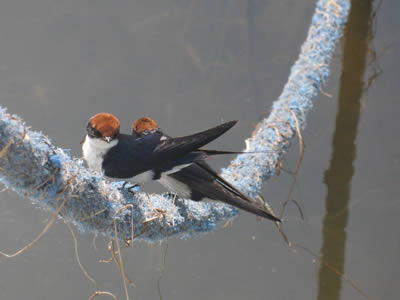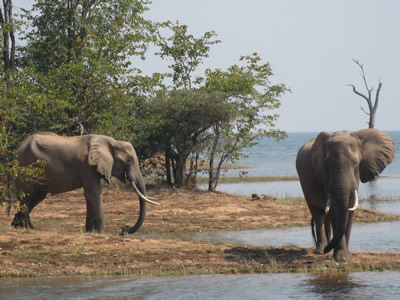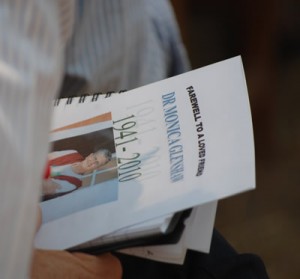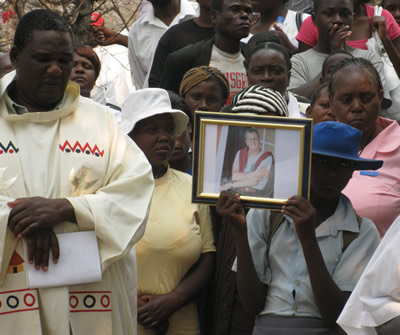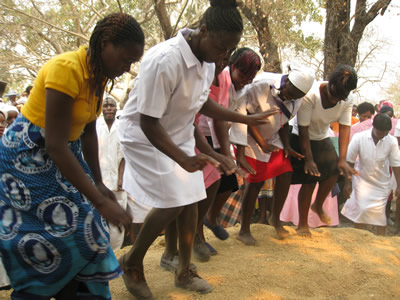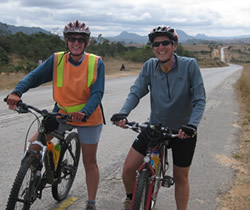
Pam and Bren, day 3
For what seems like ages, my sister Pam and I have talked about cycling from Harare to my parents’ cottage near Juliasdale in the Eastern Highlands. Early this year we picked a date, but it came and went and we were no closer to being ready to make the trip. Since the distance from Harare to the cottage is roughly 250km, we realized that we would need to do a bit of training before setting out on the journey.
We cycle together regularly, meeting early in the morning on a Saturday or Sunday to do a hilly loop that takes about 2hrs. But riding together once a week hardly seemed adequate for the endeavour – hence more procrastination. The sad truth is that I’ve been the one holding up the show.
For the last couple of years Pammy has been struggling with a bad back. The doctor says it’s not going to get better, and in fact it’s amazing how active she is given the shape it’s in. She does uncountable prostrations as part of her daily Buddhist practice, swims, goes to yoga and Pilates, plays the piano and has recently taken up the violin – never mind looking after a house full of kids.
Anyway, Pam recently decided that with the increasing pain load associated with her back, she’d opt for surgery in early September. Suddenly our options for cycling together to Juliasdale telescoped down to one or two weekends in July. Yikes. Travel and flu had combined to limit my exercise in July and I was suddenly faced with doing this ride less fit than I’d been in awhile. There was nothing for it but to trust in Muscle Memory! Hopefully my legs and chest would remember that I’d been quite fit this year.
We were easily convinced that cycling the leg from Harare to Rusape, along the Mutare Road, was for the birds. Instead, to make up a similar distance to our original route, our ride would go as follows: Day 1: Rusape to the cottage (+- 72km), Day 2: Cottage to Troutbeck and back (+- 80km), Day 3: Cottage to the bottom of Christmas Pass – about 11km out from Mutare (+- 80km).
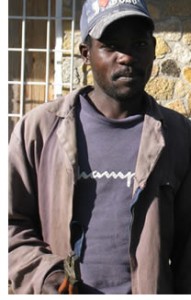
Garigayi, the bike mechanic
We set out by car from Harare on Thursday July 29th with bicycles and mini support team at the ready – Mum, Dad and Pammy’s husband, Dave. With the clock ticking down, we made the obligatory stop in Marondera to check in with my aunt Lorraine. Mum and Dad were recently back from a trip to the UK, so there was lots of catching up to be done – in Marondera and during the car trip.
When we finally pulled in at Rusape, it was well after 11am, making it a fairly late start when the two of us got underway at 11.30am.
With bottles of Game juice and pockets full of jelly babies and energy bars, we headed side by side up the long road towards Nyanga. Day one was blessed with a wintery blue sky and a cool, gentle breeze. Happily there was very little traffic on the road and we made good progress for a couple of hours. Our support team met us roughly half way with tea, sandwiches and fruit and Dave joined us to cycle the last couple of hours to the cottage. We put him to use sooner rather than later when we discovered somewhere along the way that my back tyre was flat.
By the time we reached the turn off to the Pine Tree Inn, the temperature had dropped considerably and we were very happy to be Almost There. Then a small disaster struck. Going up a steep bit of dirt road about 1km from the cottage, my chain broke. We hadn’t planned for that eventuality at all. I was miserable as we trudged up the long hill to the cottage. It seemed that nobody had the tools or the know how to fix my chain. There were still a couple of options, so all was not lost. Pam is taller than me, and Dave is taller
than Pam, so although we could swap bikes it wasn’t going to be all that comfortable the next day. The road to Juliasdale had been a fairly hilly 70km+ Up. The road to Troutbeck would be lots more Up. Actually, it seems that all the roads in the eastern highlands are a mixture of ups and downs, so relief is usually at the top of the next rise.
According to my partner Bev, cyclists in Le Tour de France are advised to have an ice bath after a long day in the saddle. My parents have a small pool at their cottage and it was Icy. Soon after we arrived, Pam and I jumped in and very quickly straight out.
A hot bath and a square meal quickly set us right, and after an early night, we were set to go the next morning.
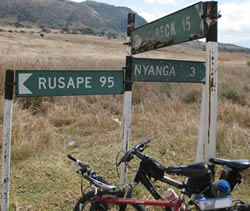
It's a long way to...
On Friday morning, the blue skies were gone, and in its stead a cloudy grey day with a brisk wind. Not what the doctor ordered for a long hilly ride to Troutbeck and back. The grey weather was completely countered by the wonderful news that a casual labourer working on a project at the cottage knew how to join a broken chain. With a long nail, a pair of pliers and a hammer, he soon had me and my chain back on my own bike. Dave had also been busy in the background and had replaced my bald back tyre with a new knobbly one! You’ve got to love the amazingly practical folk that live around you.
We set off at 9.45am and arrived, thighs burning, at Troutbeck Hotel at 12.45am. We pulled on thermal tops and tracksuit trousers and ducked into the hotel for a cup of tea and a bit of food. Service was a little slow and whilst we waited, Pammy and I pondered the option of being ferried back to the cottage by car by Dave. Nope! We wanted to do the mileage, And we wanted to cycle Down the long Up we’d cycled earlier. The ride home was no picnic and by the time we arrived back at the cottage, just after 4.30pm, we were very tired. We had our obligatory freezing plunge and followed the same routine as the night before.
The next morning I was beginning to feel a bit worse for wear. My little sister’s superior fitness was definitely starting to show. Never mind her crocked back. The weather had deteriorated and the mist hung rather low around us. We hadn’t thought to bring raincoats. Silly really, because although winters in Zimbabwe are mainly dry, the eastern highlands can be a lot more wet all the year round. Once again, as luck would have it, someone else saved the day. My parents had brought their raincoats. Rather surprising for our forgetful family. For example, my mum had brought her paints and brushes but left her art paper at home!
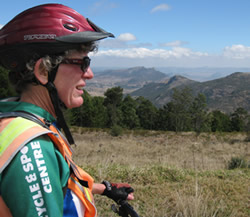
Pammy en route to Troutbeck
Pam and I were happy to have Dave join us for the start of Day 3 and we rode off in the cold drizzle together at 9am on Saturday morning. There were a lot more downs that ups, but be sure that every down had an up at the other end of it! As you can tell, I wasn’t feeling as perky on Day 3.
Thankfully the drizzle stopped after a couple of hours and the cold day warmed as we dropped height along the road to Mutare. Acres of pine trees gave way to glorious views of bush and granite kopjes and small scale farms. Cattle and goats on the side of the roads looked in good condition and commuters plied the road between busy rural business centres.
Dave hopped off his bike and into the support car after about two and a half hours, leaving Pammy and I to finish the journey off together. About 12km away from our designated end, we started to discuss the possibility of doing the extra Big Up and Down into Mutare. Christmas Pass is 11km Up and Down into Mutare. Just then the support car pulled up to check on our progress. We mentioned our recent thoughts. Their response was … “It’s enough already!” They had put their collective feet down after hours of hanging about for us over 3 days of cycling. And, coincidentally, saved Pammy and me from our Burrell-ness – enough is never enough if there’s another hill to be climbed. I suspect they also saved me from a bust gut. I was done for, even if Pammy still had miles left in her legs.



